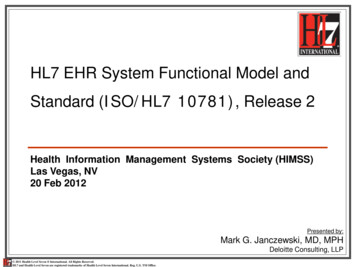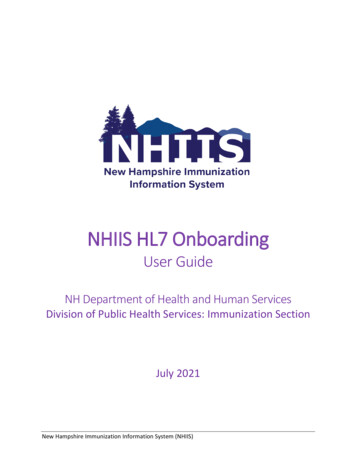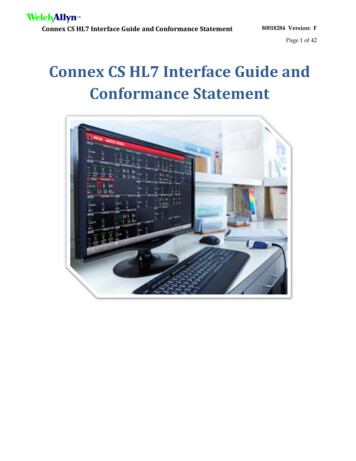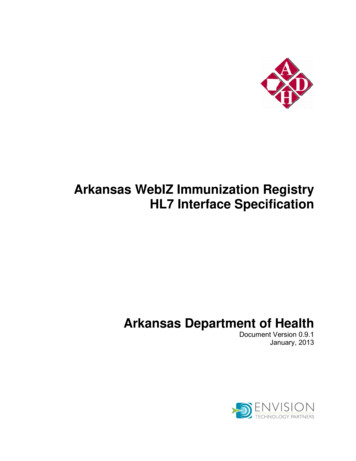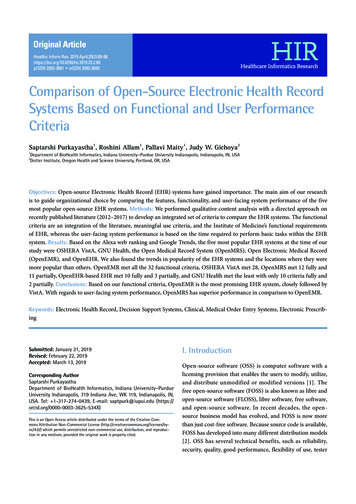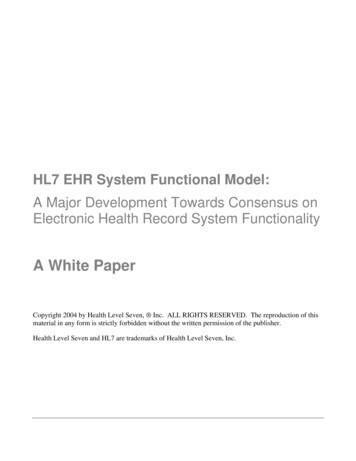
Transcription
HL7 EHR System Functional Model:A Major Development Towards Consensus onElectronic Health Record System FunctionalityA White PaperCopyright 2004 by Health Level Seven, Inc. ALL RIGHTS RESERVED. The reproduction of thismaterial in any form is strictly forbidden without the written permission of the publisher.Health Level Seven and HL7 are trademarks of Health Level Seven, Inc.
Table of Contents:1.Purpose. 12.Overview of HL7 EHR System Functional Model. 13.Background . 24.Definitions. 35.HL7 EHR-S Functional Model . 45.1Phased development. 45.1.1Draft Standard for Trial Use . 45.1.2Next Steps . 55.2Functional Model Overview . 55.3Future development of the Model: Functional Profiles . 55.4Functional Profile Overview. 75.4.15.5Realm-specific Profiles and Suggested Approach. 7Applications of the EHR System Functional Model. 85.5.1Vendor Perspective . 85.5.2Provider Perspective . 95.5.3Patient Perspective . 9Appendix A. Overview of related EHR standards. 10Purpose of EHR standards . 10Scope of EHR standards . 10Classification of EHR standards . 11Core interoperability standards . 11Content standards. 11Standards for EHR-related services . 12Standards for specific EHR technologies, sectors and stakeholders. 13i
EHR meta standards. 13Appendix B: Current International EHR Standards Activities . 14Overview. 14ISO/TC 215. 14CEN/TC 251 . 15Health Level Seven (HL7) Standards . 17EHR-S Interoperability . 17Conformance using Functional Profiles. 18Harmonization. 18Appendix C: Future International Directions for EHR Standards . 19EHR interoperability standards. 19Generic EHR interoperability standards . 19Standardizing archetypes and templates . 19EHR content standards. 20EHR-related standards . 20Terminology standards. 20Service interface standards . 21Where do messaging standards fit with the EHR?. 21Appendix D: EHR-S Functional Outline . 23References. 24ii
HL7 EHR-S Functional Model and Standard: White PaperPlease Note:The content within this white paper is not content which can be voted on. It is presentedstrictly as a reference document for those ballot readers that are interested in thisadditional information. There is some wording used in this White Paper that isnormative in other places of the ballot package and able to be voted upon in the EHRSystem Functional Model Standard Overview document; however, identification of thenormative content takes place in the Standard Overview and votes are then placed inthe Ballot spreadsheet.For the remainder of this document, the HL7 EHR System Functional Model andStandard will be referred to as the ‘EHR-S Model’ or ‘the proposed DSTU’.1.PurposeThe purpose of this White Paper is to provide a comprehensive background for the HL7 EHRSystem Functional Model that is being balloted as a Draft Standard for Trial Use (DSTU).Much of the information found in the EHR System Functional Model and Standard Standard Overview document is included in this White Paper, but there will also be a greatdeal of additional, background information in this document that is out of scope for the briefStandard Overview document. This White Paper will provide additional information aboutthe use of profiles to select applicable functions for use, the context within which this ballotwas created, and EHR System related standardization efforts around the world.2.Overview of HL7 EHR System Functional ModelThe HL7 EHR System Functional Model and Standard Draft Standard for Trial Use (DSTU)is intended to provide a summary understanding of functions that may be present in anElectronic Health Record System (EHR-S), from a user perspective, to enable consistentexpression of system functionality. This EHR-S Model describes the behavior of a systemfrom a functional perspective and provides a common basis upon which EHR-S functions arecommunicated. The DSTU can help vendors describe the functions their systems offer, andhelp those planning new purchases or upgrades to describe the functions they need.For brevity, this draft standard will be referred to within this document as the “EHR-SModel” or the “proposed DSTU” where the meaning is not ambiguous. A DSTU is a draftstandard that incorporates the input from industry prior to becoming a formal ANSI standard.(See Appendix D “What is a DSTU?”)Notably, the EHR-S DSTU does not address whether the EHR-S is a system-of-systems or asingle system providing the functions required by the users. The specifics of ‘how’ EHR-S’sare developed or implemented is also not considered to be within the scope of this DSTUnow or in the future. It does not address or endorse implementations or technology; neitherdoes it include the data content of the Electronic Health Record (EHR).HL7 EHR System Functional Model: A White PaperCopyright 2004 by Health Level Seven, Inc.Page 1
This DSTU is not:3. A messaging specification. An implementation specification. A conformance specification. An ANSI Standard. An EHR specification. (Note: Electronic Health Records and Electronic HealthRecord Systems are different entities.) A conformance or compliance metric. An exercise in creating a definition for an EHR or EHR-S. (ISO is currentlyaddressing this task.)BackgroundThe effective use of information technology is a key focal point for improving healthcare interms of patient safety, quality outcomes, and economic efficiency. A series of reports fromthe Institute of Medicine (IOM) identifies a crisis of “system” failure and calls for “system”transformation enabled by the use of information technology. Such a change is possible by“an infrastructure that permits fully interconnected, universal, secure network of systems thatcan deliver information for patient care anytime, anywhere.”( HHS Goals in Pursuing HL7EHR Functional Standard” in Memorandum to HIMSS from C. Clancy and W. Raub cochairs of HHS Council on the Application of Health Information Technology, datedNovember 12, 2003.) A critical foundational component for resolving these system andinfrastructure issues is the Electronic Health Record System (EHR-S).The U.S. Department of Health and Human Services, the Veterans Health Administration aswell as the Health Information Management Systems Society and the Robert Wood JohnsonFoundation, in a public-private partnership, approached HL7 to develop a consensus standardfor defining the functions of an EHR-S. HL7, through its EHR Special Interest Group (EHRSIG), responded by developing an EHR-S Functional Model to be balloted as a DraftStandard for Trial Use (DSTU). Learning important lessons from its earlier DSTU, the HL7EHR SIG now offers a clearer, more simplified functional outline, while delegatingspecification of care settings and priorities to individual realms.HL7’s Electronic Health Records Special Interest Group (EHR SIG) was established in thespring of 2002 and in the spring of 2003started to develop a standardized functionalspecification for Electronic Health Records Systems with the intention of promoting theuptake of Electronic Health Record implementation by standardizing the essential functionsof a generic Electronic Health Record System.Please note: The content within this white paper is presented as a reference document for readersinterested in additional information regarding this DSTU. For the remainder of this document,the HL7 EHR-S Functional Model will be referred to as the 'EHR-S Model' or 'Proposed DSTU'.HL7 EHR System Functional Model: A White PaperCopyright 2004 by Health Level Seven, Inc.Page 2
4.DefinitionsUntil recently there was no generally agreed definition for an EHR. The first publishedinternational EHR technical specification “ISO/TS 18308: 2004 Health informaticsRequirements for an Electronic Health Record Architecture” [1] contains seven differentdefinitions drawn from the United States, Australia, Europe and Canada. These definitionshave more similarities than differences but reflect slightly different shades of meaningbetween different countries and organizations.Many different names and definitions have been broadly used. These include: Electronic Medical Record (EMR) Electronic Patient Record (EPR) Computerized Patient Record or Computer-based Patient Record (CPR) Electronic Health Care Record (EHCR) Virtual EHR Personal Health Record (PHR) Digital Medical Record (DMR)It is important to note that the DSTU does not attempt to establish another definition for EHRSystems, but chooses to utilize existing definitions that include the concept of EHR Systemsas a system (at least one) or a system-of- systems that cooperatively meet the needs of theend user.4.1 Electronic Health Record Systems (EHR-S) DefinitionsIn developing the DSTU, HL7 relied on three well-accepted definitions: two provided by theU.S. Institute of Medicine (IOM) and one developed by the European Committee forStandardization/ Comité Européen de Normalisation (CEN).Existing EHR System DefinitionsThe Institute of Medicine’s 1991 report, Computerized Patient Record, defined the EHRSystem as:“The set of components that form the mechanism by which patient records arecreated, used, stored, and retrieved. A patient record system is usually locatedwithin a health care provider setting. It includes people, data, rules andprocedures, processing and storage devices (e.g., paper and pen, hardware andsoftware), and communication and support facilities.”The 2003 IOM Letter Report, Key Capabilities of an Electronic Health Record System,defined the EHR System as including:HL7 EHR System Functional Model: A White PaperCopyright 2004 by Health Level Seven, Inc.Page 3
“(1) longitudinal collection of electronic health information for and aboutpersons, where health information is defined as information pertaining to thehealth of an individual or health care provided to an individual; (2) immediateelectronic access to person- and population-level information by authorized,and only authorized, users; (3) provision of knowledge and decision-supportthat enhance the quality, safety, and efficiency of patient care; and (4) supportof efficient processes for health care delivery.”The 2003 ISO/TS 18308 references the IOM 1991 definition above as well as CEN 13606,2000:“A system for recording, retrieving and manipulating information in electronichealth records.”5.5.1HL7 EHR-S Functional ModelPhased developmentThe HL7 EHR System Functional Model will be developed using a phased approach.5.1.1Draft Standard for Trial UseThe first step of the development will consist of a Draft Standard for Trial Use. This type ofstandard specification is intended by HL7 to be developed for the distinct purpose ofenabling trial use of the specification prior to the balloting of a full-fledged ANSI standard.The DSTU period can last for up to two years and consists of receiving and incorporatingindustry and HL7 feedback while moving towards the goal of balloting parts or all of theDSTU as an ANSI standard.The DSTU will consist primarily of a list of Function Names and Function Statements thathave been identified through a global development and review process as essential in a caresetting now or in the future. The list of functions is analogous to a dictionary, which is anexcellent example of a superset (vs. a subset). In this dictionary, Function Names are definedand available for reference or for selection when composing a list of functions that aredeemed necessary by the user. In other words, a user of the EHR-S DSTU may want to lookup a function to gain an understanding of how that function is used, or, a user may want toselect a number of functions to create a document to communicate functional needs to others.As with other dictionaries, the proposed DSTU is expected to evolve over time to reflectempirical needs and uses for EHR-S functions.Note that the proposed DSTU is deliberately leaving out conformance criteria. Minimalconformance criteria are planned at the function level, (not the system level) and will statewhat is needed to determine whether a single function exists. Conformance criteria will bestated in user-oriented, system-behavior language, similar to a Function Name and FunctionStatement. This will not establish conformance criteria for comparing EHR Systems to theentire superset of functions. The development of the minimal conformance criteria will beperformed with industry input and guidance.HL7 EHR System Functional Model: A White PaperCopyright 2004 by Health Level Seven, Inc.Page 4
5.1.2Next StepsDuring the DSTU period, as the standard is applied in healthcare informatics and feedback isbeing incorporated, the document will be continually refined. After the DSTU period, thelessons learned and good practices developed will be included in the next version of theEHR-S Functional Model which will be balloted as standard. The HL7 EHR SIG willdetermine both the time and the content when the proposed DSTU will be promoted to fullstandard status. The HL7 EHR SIG has seen its membership group expand by fivefold during the DSTU development phase and is deeply grateful for the immense amount ofoutside knowledge and expertise that has been brought to this process. It is hoped that thislarger group, and others, will continue to participate in the process of modifying the originalDSTU into a future standard.5.2Functional Model OverviewThe EHR-S Functional Model consists of a set of Functions and their associated FunctionalDescriptors. These functions are divided into three sections: Direct Care, Supportive, andInformation Infrastructure.These functions are intended to become the common language used by vendors, providers,regulators, policymakers, and other parties when describing the capabilities of theirapplications (vendors), their needs (providers) their quality requirements (regulators), orother purposes. Additionally, realm specific HL7 International Affiliates may endeavor tocreate their own country specific language. (See Functional Profiles below).5.3Future development of the Model: Functional ProfilesProfiles help to manage the master list of functions. A “Profile” is a selected set of functionsthat are applicable for a particular purpose, user, care setting, domain, etc. It is notanticipated that the full set of functions will apply to any single EHR-S implementation.Instead, the functions are profiled for particular care settings and for particular uses. CareHL7 EHR System Functional Model: A White PaperCopyright 2004 by Health Level Seven, Inc.Page 5
Setting Profiles relate priorities (Essential/Now, Essential/Future, Optional, Not Applicable)to specific functions. Ultimately, self-generated Profiles will express the capabilities of areal system (e.g., a vendor’s product or a set of applications) or the needs of a stakeholder(e.g., providers, national health organizations, or insurers).The expression of Priorities (Essential/Now, Essential/Future, Optional, Not Applicable)allows users to better list what is currently desired for their needs and what is realisticallyachievable in the near future. (See definitions of Priorities below.)HL7 EHR System Functional Model: A White PaperCopyright 2004 by Health Level Seven, Inc.Page 6
The possible priorities assigned to a function in a specific Healthcare Delivery Setting maybe:PriorityDescriptionEssential NowThe function must be feasible to implement now or within 18months. That is, the function is readily available and the users canimplement it. The function must also be critical or key to helpingan EHR system address at least one of the following criteria [2]:Essential Future Support Delivery of Effective Healthcare Improve Patient Safety Facilitate management of chronic conditions Improve efficiency Facilitate self-health managementThe function should be feasible to implement by users and readilyavailable in the future. The function must be also be critical or keyto helping an EHR system address at least one of the followingcriteria [2]: Support Delivery of Effective Healthcare Improve Patient Safety Facilitate management of chronic conditions Improve efficiency Facilitate self-health managementOptionalA level of significance applied to functions in relation to afunctional profile. For the average users, the function is deemed animportant/desirable but not a critical/key/essential component to anEHR system. It is recognized that for more complex healthcareprovider settings, many items deemed optional may be viewedessential to them.Not applicable/supportedA level of significance applied to functions in relation to afunctional profile. The function is deemed an unsuitablecomponent for an EHR system, in relation to a specific functionalprofile.5.45.4.1Functional Profile OverviewRealm-specific Profiles and Suggested ApproachThe development of a Profile can be done by an individual, an organization, a vendor or agroup of subject matter experts. The U.S. Realm reference portion of this ballot package hasfour examples of Profiles that were created by subject-matter experts from four careenvironments: Acute Inpatient, Care in the Community, Long-Term Care, and Ambulatory.HL7 EHR System Functional Model: A White PaperCopyright 2004 by Health Level Seven, Inc.Page 7
These four example profiles are found in the reference portion of the DSTU documents.These profile examples are in not way intended as a benchmark for the selected care settings.They are well-developed examples of how profiling activities may be conducted. Steps include:a) Identify participants for a workgroup that would create a Profile. The members mayvary based on the type of profile, but generally should be subject-matter experts orstakeholders in the area/setting being profiled.b) Define the area/setting to be profiled and establish the scope. For example, is theprofile for a specific function which crosses multiple settings or is it for a single caresetting?c) Review the functional name, statements, descriptions and references in the existingEHR-S Functional Model. Consider these questions: Do the functions in the EHR-SModel apply to this Profile? Are certain functions required, but missing from theModel? (If functionality is missing, please notify HL7's EHR SIG for future revisionsto the Model).d) Review the existing functions in the model for the area/setting profiled to determineeach function's priority. Determine whether each function is essential now, essentialin the future, optional, or not applicable for the area/setting.e) Create a use-case scenario or case study for the area/setting profiled. The case studywould provide an example of how the functionality of the EHR-S Model would beapplied to the area/setting. The use-case/case study would depict situations unique tothe area/setting profiled and assist a reader in understanding how the EHR-SFunctional Model would be applied in that unique situation or setting. When afunction is described in the use-case scenario/case study, the function ID is referencedto tie the example back to the EHR-S Functional Model.f) Complete the three profile documents (Definition of Area/Setting Profiled, SettingSpecific Model with Priorities, and Case Study) and submit the documents to theEHR SIG for review and comment. (Note: HL7 plans to maintain a library of theProfiles, but the process and procedure is currently not defined.)5.55.5.1Applications of the EHR System Functional ModelVendor PerspectiveVendor – The HL7 EHR-S Functional Model & Standard judiciously stays away fromimplementation issues. The vendor generated innovation and applicable know-how is whatwill give life to the functions within the model. It is this innovation that is deemedirreplaceable and led the EHR SIG to remain away from the implementation ‘how’ issues.The use of the term ‘systems’ after EHR was purposely put in to indicate that vendors whohave niche markets are just as important within the system as vendors who have large EHRproducts. The Functional Model will provide a communication tool by which a vendor nicheproduct can communicate to a client that they meet all the functions and exceed by a largemargin in the target area in which the client is focused.HL7 EHR System Functional Model: A White PaperCopyright 2004 by Health Level Seven, Inc.Page 8
5.5.2Provider PerspectiveProvider – The HL7 EHR-S Functional Model and Standard will give providers a commonlanguage to use when discussing functions that should be present within an EHR-S. Bygiving the provider a function name and definition that is standard throughout the industry,the provider has increased confidence in universal understanding when purchasing and usingEHR-S functions.5.5.3Patient PerspectivePatient – The HL7 EHR-S Functional Model & Standard documents key functions that willenable patients to play an important role in their own healthcare. Systems that support thesefunctions will provide decision support tools for self-health management, and make itfeasible for patients to update their health records and better communicate with theirproviders.HL7 EHR System Functional Model: A White PaperCopyright 2004 by Health Level Seven, Inc.Page 9
Appendix A. Overview of related EHR standardsPurpose of EHR standardsThe major purpose of EHR standards (and many other health technology standards) is tofacilitate improvements in five main areas:1. Interoperability2. Safety/security3. Quality/reliability4. Efficiency/effectiveness5. Communication (i.e. verbal and written communication to improve understandability)These are clearly all important benefits and most standards will assist to a greater or lesserextent in achieving all five of these benefits. However, interoperability is arguably the singlemost important benefit of EHR standards since this is the area most lacking in healthinformation management today. Furthermore, without interoperability, the ability to achievethe other three benefits is significantly limited.Scope of EHR standardsIn 2001, ISO/TC 215 established the EHR ad hoc Task Group to identify gaps andrequirements for international standards for Electronic Health Records. The final report ofthis Group in 2002 [6] made 10 recommendations. The first three of these recommendationswere:1. ISO/TC 215 should develop a comprehensive consensus definition of the EHR.2. ISO/TC 215 should define EHR standards as part of a family of standards based on a“system-of-systems” approach that collectively represents the major services in adistributed health-computing environment.3. ISO/TC 215 should restrict the scope of EHR standards to a conception of the EHRthat is concerned with a single subject of care, has as its primary purpose the supportof present and future health care, and is principally concerned with clinicalinformation.The first of these recommendations is in its fourth (and potentially final) Draft TechnicalReport in the ISO 20514 project [2]. The second and third recommendations are interestingbecause they implicitly define the scope of EHR standards activity, at least for ISO. Thereare two quite distinct views on the scope of the EHR and of EHR systems. These have beencalled the “Core EHR” and “Extended EHR” [2] views. The Core EHR view is that thescope of the EHR (and therefore of EHR systems) is concerned principally with clinicalinformation and the care of individual patients (as per Recommendation 3 above) andexcludes other components of a comprehensive clinical information system (such asdemographics, security, terminology, and decision support(as per recommendation 2 above)).The Extended EHR view is that the scope of the EHR and EHR systems includes not only theHL7 EHR System Functional Model: A White PaperCopyright 2004 by Health Level Seven, Inc.Page 10
related EHR “building block” services such as terminology and security, but also non-clinicalfunctions such as patient administration, scheduling, billing, and resource allocation. Theissue of EHR/EHR-S scope is discussed further in ISO 20514.One very practical reason for adopting the more limited scope for the EHR/EHR-S is that it isdifficult enough to create EHR standards for even the limited scope. Many would say that itis impossible to create EHR standards if the scope of the EHR/EHR-S is effectively extendedto include all of health informatics (and beyond). Rather, “The best way to eat an elephant isin small pieces”.Classification of EHR standardsThere is no formally accepted classification of EHR standards. But one approach used in theISO EHR ad hoc Group Report [6] is described below1.Core interoperability standardsThere are at least six important types of standards that contribute to EHR interoperability,including unique identification of the subject of care and standardized EHR systemfunctionality – but these will be discussed under other headings.The ISO EHR ad hoc Group classification lists four key pre-requisites necessary to achievesemantic interoperability of EHR information, with the first two of these also being requiredfor functional interoperability2:1. A standardized EHR Reference Model (namely, the EHR information architecture)between the sender (or sharer) and receiver of the information.2. Standardized service interface models to provide interoperability between the EHRservice and other components such as demographics, terminology, access control andsecurity services in a comprehensive clinical information system.3. A standardized set of domain-specific concept models, namely, archetypes andtemplates for clinical, demographic, and other domain-specific concepts.4. Standardized terminologies (which underpin the archetypes).Content standardsContent standards is an important category of standards that can be further subdivided into“content standards for the ”HR" and “content standards for EHR systems”. EHR content is1The approach to standards classification described here is framed by the ISO RM/ODP methodology [7] andtwo-level modelling used by both HL7 V3 and the CEN/openEHR standards groups. An alternativeclassification based on the ISO Health Informatics Profiling Framework is also described in [6].2The four points below are reproduced directly from ISO 20514. A further discussion on the key role ofinteroperability for EHRs can be found in section 4.2 of that document.HL7 EHR System Functiona
Electronic Health Record System (EHR-S), from a user perspective, to enable consistent expression of system functionality. This EHR-S Model describes the behavior of a system from a functional perspective and provides a common basis upon which EHR-S functions are communicated. The DSTU can help vendors describe the functions their systems offer .

